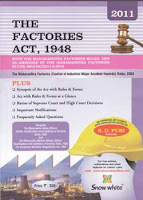Mr. Arun Maira (Member - Planning Commission) writes in ET Edit Pages quite frequently with a specific focus on Manufacturing. First up, Mr. Arun Maira is a man with highly decorated professional career and a proven track record through some of the finest companies. While commenting on his writings, this is to put on record that his credentials & professional work is always appreciated and respected. What draws my attention to his articles on Manufacturing is the evident lack of substance, sheer emptiness, semantics and the romanticism about the general manufacturing scene and scope in India. I ask myself - what happens to these extra-ordinary people with a glittering professional track record the moment they arrive at a position of such authority and power as that of a Member Planning Commission? This is where they actually can contribute big time, rather than just comment or rant like an ignorant common-man like me.
The fact is, as a country, we have completely skipped the Manufacturing revolution. Thanks to the political apathy and the complete absence of a focused and aggressive manufacturing policy, labor reforms etc; to support and build a robust manufacturing sector. Liberalization of the 90’s did nothing to directly help the manufacturing sector. As a result, we have jumped the gun from Green revolution to the (knowledge-based IT) Services revolution. The mixed bag of Socialist, Socialist-Communist and the Socialist-Liberal (read Crony Capitalist) policies never allowed the manufacturing sector to bloom and grow in a truly free-market economic environment. Therefore any talk on Manufacturing has to start from this point, failing which I would simply call it as empty talk, semantics, romanticism and rant. Quoting Mr. Arun Maira from one of his earlier articles: "India needs a strategy to grow manufacturing 12% to 14% per annum, create 100 million new manufacturing jobs in the next 15 years to realise its 'demographic dividend', and create more depth in capital goods industries and innovation for its manufacturing sector to be competitive and sustainable." Very well said and I fully agree – but the timing of this comment in the year 2011 I thought was completely misplaced – it sounds like a “period” rant - this was supposed to have been written in the late 80s and early 90s. It is too late to make such a generalized comment now, and too naïve coming from a Member Planning Commission of the stature of Mr. Arun Maira. In yet another and a more recent article of 13th June ET – Releasing Brakes on Manufacturing, Mr. Maira once again used key words such as Competitive-Positioning and Competencies. Long winding explanations and almost the entire article laced with management vocabulary was totally devoid of any mention of a crying need for a policy guideline to make this whole manufacturing thing work for India. The very brief and almost insignificant mention of “Constraints” is very beautifully generalized so as not to hurt any of those who matter - to him and his current position, I guess. Sitting in the high offices, as the Member Planning Commission, from the position of framing national policies and advising the Government on key policy issues, I would have expected a better and more specific material in his articles rather than “generalized comments”. We need a more focused and specific point-by-point road map leading to the manufacturing revolution. Incidentally, in the same newspaper, few pages away is a very catchy headline that reads – Factory Floor, Not IT Park, Crucial to India Growth, by Sanjay Mathur. A very convincing and a solid argument put forth as to why India needs to focus on manufacturing economy.
Where are the basic policies to support the manufacturing economy? Where is the political-will and the determination to promote and open-up the Industrial & Manufacturing sector in the true sense of the word? Where the labor pool is going to come from to fill up these large factories? Where are the training and skill-set development institutes (Polytechnics and not the IITs) to support large scale manufacturing? Needless to even mention the usual road-blocks: shabby infrastructure, deep-rooted Corruption starting at lowest levels, Bureaucratic hurdles and red-tape. Even today you show the same old rule book to the Indian manufacturer - The Factories Act, 1948.
Factory Inspector, Pollution Control, Fire Inspector, Labor Inspector, PF, ESI, Sales-Tax, Income-Tax, VAT, Service-Tax, Customs, Central Excise; these are but a few of your esteemed regulators, the list goes on and on. An Indian manufacturer must always remain in the “good books” of each one of these offices – complying every single rule which. On a best effort basis, it is almost next to impossible for any manufacturer to comply 100%, and hence you pay protection money and rents at regular intervals. Even worse, complying 100% does not mean one can get away without paying friendly rents - as per the current practices, only if the paperwork is in order and everything is perfect, one must pay rent. Non-compliance means huge protection money with little penalties on paper. If not, no manufacturer would survive even for a day. So you first create barriers and then seek rents to allow safe passage. Everyone, including Mr. Maira, is fully aware about this monster army of notorious regulators and inspectors. And yet you chose to ignore the ground realities, write nice sounding articles which readily find due space on the edit pages of leading newspapers. Talk of Manufacturing growth @ 12% to 14% per year, 100 million new jobs over 15 years to be able to reap the benefits of ‘demographic dividends’ and so on.
Of course, a manufacturer must pay due taxes, follow the governing laws and regulations, observe fair employment practices and you do need a regulator to monitor all such compliance. But it is high time you changed the Manual first – The Factories Act, 1948. More precisely, The Factories Act, 1948 (Act No. 63 of 1948), as amended by the Factories (Amendment) Act, 1987 (Act 20 of 1987). That rule book was exclusively designed by the Hardcore Socialists to monitor and regulate State-Manufacturing post independence, duly preserved and followed in word and spirit, by the next generation of even more corrupt Socialists, more so to extort rents and share the loot. Surely you are not serious and would not expect a manufacturer in 2011 achieve global competitive-position and competency, complying with the dated Hand Book of 1948. It is like generously allowing one Mr. Vijay Mallaya to own F1-Team at Formula-One circuit with a rider that he can only use the 1948 Ambassador to compete with the Ferraris of the world.
 Despite the poor governance, pathetic infrastructure, almost non-existent manufacturing policy and dated labor laws, Indian manufacturing has done its bit as shown in this article – India among world’s top 10 manufacturing nations: UNIDO. This article says some nice things about Indian manufacturing and highlights the small contribution of Indian Manufacturer making a big difference to the Indian economy. Just to counter Mr. Arun Maira one last time and specifically his latest article about Competitive-Positioning, I quote from this article: "Competitiveness of Indian manufactured goods in the global markets has significantly improved," Chief Statistician of the United Nations Industrial Development Organisation (UNIDO) Shyam Upadhyaya said while releasing the report. A more recent article on 20th June ET shows some hope and light at the end of a long dark manufacturing tunnel – New manufacturing policy likely to give impetus to the sector.
Despite the poor governance, pathetic infrastructure, almost non-existent manufacturing policy and dated labor laws, Indian manufacturing has done its bit as shown in this article – India among world’s top 10 manufacturing nations: UNIDO. This article says some nice things about Indian manufacturing and highlights the small contribution of Indian Manufacturer making a big difference to the Indian economy. Just to counter Mr. Arun Maira one last time and specifically his latest article about Competitive-Positioning, I quote from this article: "Competitiveness of Indian manufactured goods in the global markets has significantly improved," Chief Statistician of the United Nations Industrial Development Organisation (UNIDO) Shyam Upadhyaya said while releasing the report. A more recent article on 20th June ET shows some hope and light at the end of a long dark manufacturing tunnel – New manufacturing policy likely to give impetus to the sector.

Comments
Post a Comment